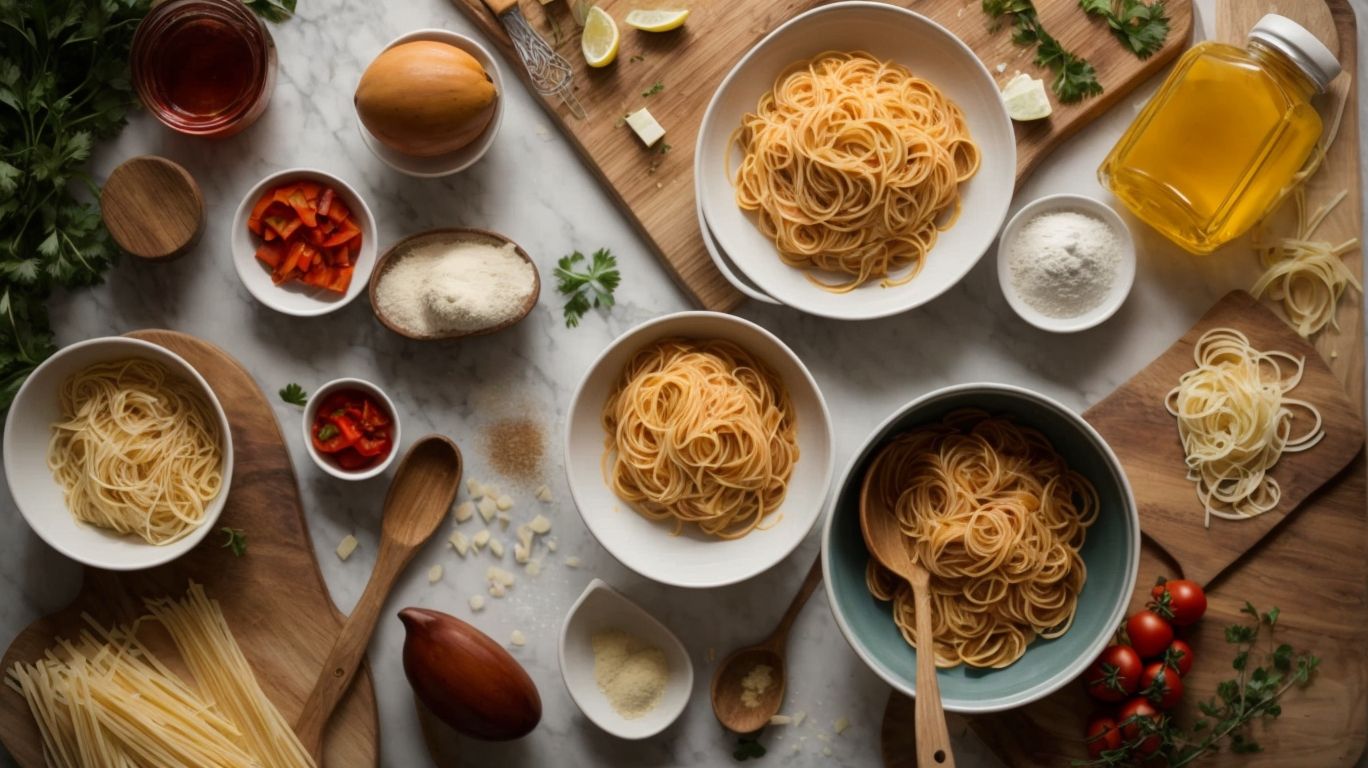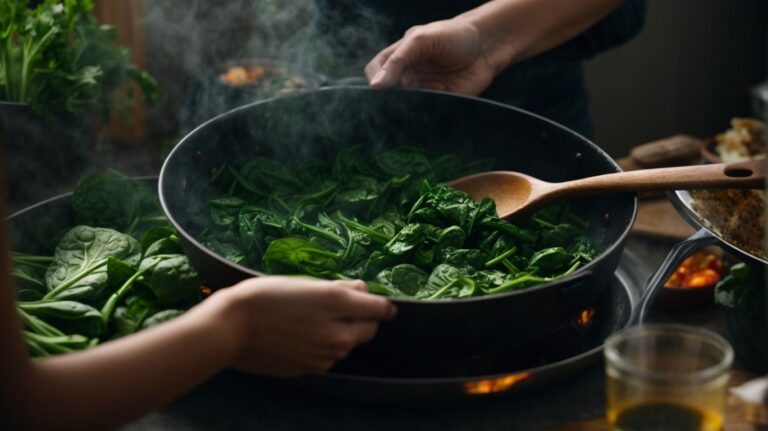How to Cook Spaghetti?
Are you looking to create the perfect bowl of spaghetti but not sure where to start?
In this article, we will explore the art of cooking spaghetti, from the necessary ingredients to the essential equipment needed.
Follow along as we provide a step-by-step guide to cooking the perfect spaghetti dish, along with some helpful tips and tricks to elevate your meal.
Whether you’re a seasoned chef or a beginner in the kitchen, this article has something for everyone. Let’s get cooking!
Key Takeaways:
What is Spaghetti?
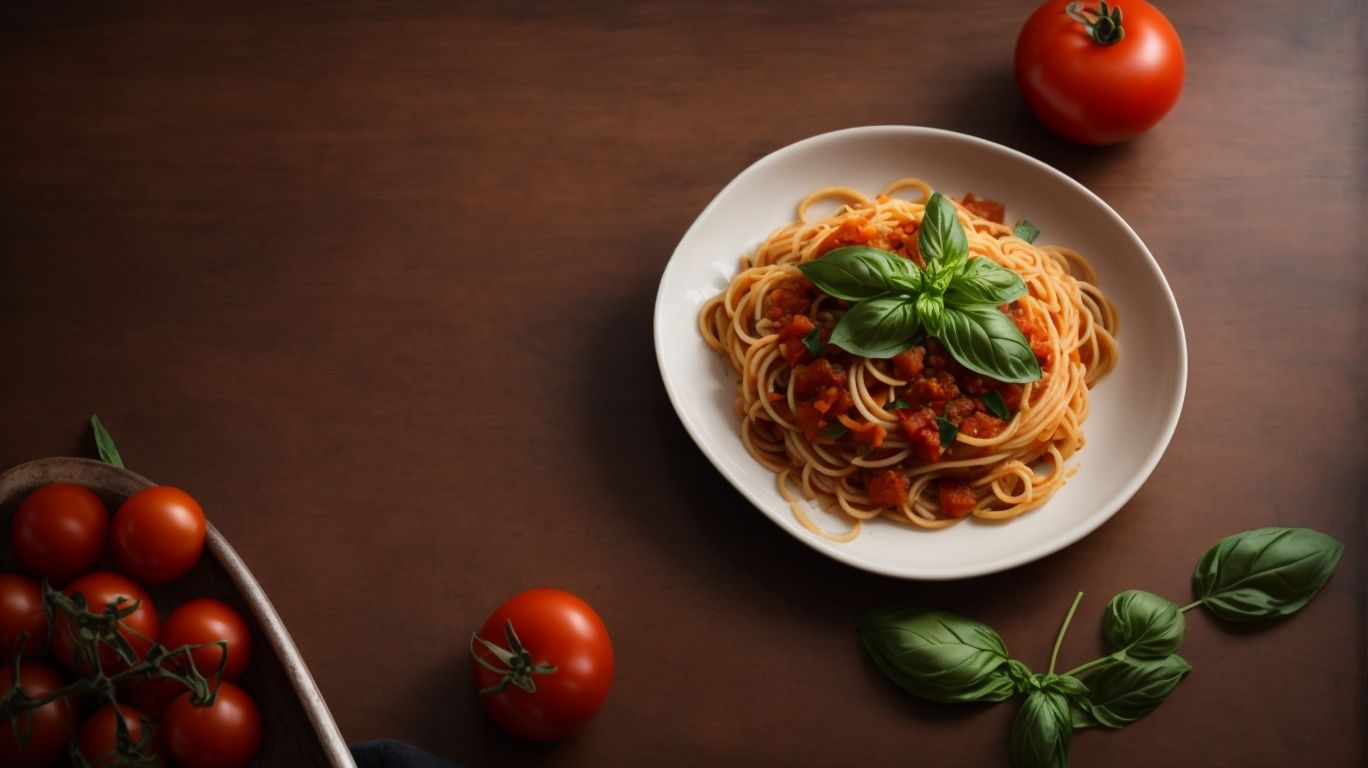
Credits: Poormet.Com – Eric Jones
Spaghetti is a type of pasta that is long, thin, and cylindrical, originating from Italy and commonly served with various sauces.
Known for its versatility, spaghetti is a staple food in Italian cuisine and is enjoyed worldwide for its simple yet delicious flavor profile. The long strands of spaghetti are made from durum wheat semolina, giving them a firm texture when cooked to perfection.
Plus being a popular food choice, spaghetti holds cultural significance in Italian traditions and is often associated with family gatherings and special occasions. It is a comfort food for many and has become a symbol of warm hospitality and togetherness.
There are various ways to cook spaghetti, including boiling it in salted water until al dente, which means ‘to the tooth’ in Italian, ensuring a firm bite. Spaghetti can be paired with a wide range of sauces like marinara, carbonara, Alfredo, or bolognese, each offering a unique taste experience.
When serving spaghetti, it is common to garnish it with fresh herbs like basil or parsley and grated Parmesan cheese for an extra burst of flavor. The simplicity and adaptability of spaghetti make it a go-to choice for quick and satisfying meals that can be enjoyed by people of all ages.
What Ingredients Do You Need to Cook Spaghetti?
To cook spaghetti, you need essential ingredients such as pasta, sauce, and optional additions like meat and vegetables.
When preparing spaghetti, the pasta is the fundamental ingredient. Choose spaghetti noodles, ideally long and thin, which hold sauce well. The sauce is what brings flavor to the dish. You can opt for a classic marinara sauce made from tomatoes, garlic, and herbs, or explore creamy Alfredo or rich Bolognese varieties. Incorporating meat such as ground beef, sausage, or meatballs can add protein and depth to your dish. Vegetables like peppers, mushrooms, or spinach offer a pop of color and nutrients, enhancing the overall dish.
Pasta
The foundation of any spaghetti dish is the pasta, usually made from durum wheat, and available in various shapes and sizes.
When cooking pasta for a classic spaghetti recipe, it’s crucial to select the right type that complements the sauce. The water-to-pasta ratio plays a significant role in achieving the perfect al dente texture. Remember to generously salt the boiling water to enhance the overall flavor of the pasta. Various pasta shapes, such as spaghetti, linguine, or fettuccine, can alter the eating experience and how well they cling to the sauce. Experimenting with different shapes allows for versatile dishes that can cater to various preferences.
Sauce
The sauce for spaghetti can vary from classic options like Bolognese and carbonara to quick and easy techniques using pantry staples like garlic and herbs.
Regarding creating a memorable spaghetti dish, the choice of sauce plays a crucial role in defining the overall flavor profile. Traditional recipes like Bolognese, with its rich meaty sauce simmered for hours, or the creamy indulgence of carbonara with eggs, cheese, and pancetta, showcase the diversity of pasta sauce options available.
For a more everyday approach, experimenting with pantry ingredients like garlic can elevate a simple spaghetti meal into a flavorful delight. Harnessing the aromatic qualities and depth of flavor offered by garlic can transform a basic sauce into a culinary masterpiece.
Meat (Optional)
Adding meat to spaghetti dishes offers protein-rich options such as ground meat in Bolognese sauce or flavorful Italian meatballs.
Regarding preparing a hearty Bolognese sauce with ground meat, you’ll need a blend of aromatic vegetables like onions, carrots, and celery to enhance the flavor profile. The cooking process involves browning the meat to develop rich flavors that will complement the tomato-based sauce perfectly.
- For those craving authentic Italian meatballs, a blend of ground beef and pork mixed with breadcrumbs, herbs, and Parmesan cheese creates a savory and tender bite. These meatballs can be simmered in a simple tomato sauce to absorb all the delicious flavors.
It’s important to note that meat contributes significantly to the protein content of these dishes, making them a hearty and satisfying meal option. Sprinkling freshly grated Parmesan cheese over your spaghetti adds a delicious umami flavor that enhances the overall taste.
Vegetables (Optional)
For a healthier twist, consider adding vegetables like zucchini noodles, spaghetti squash, or aromatic ingredients like garlic and fresh basil leaves to your spaghetti.
Vegetables can be a fantastic addition to spaghetti dishes, not only enhancing the nutritional value but also adding a depth of flavors and textures. Zucchini noodles, also known as zoodles, are a great low-carb alternative to traditional pasta, while spaghetti squash offers a delicious gluten-free option.
Aromatic elements like garlic and basil leaves can elevate the taste profile of your spaghetti, infusing it with fragrant and savory notes. They can transform a simple dish into a culinary delight.
Regarding preparing pantry-based meals, vegetables are your best friend. They can be versatile ingredients that add color, nutrients, and variety to your cooking repertoire. Next time you’re cooking spaghetti, experiment with incorporating more vegetables to create a wholesome and flavorful meal.
What Equipment Do You Need to Cook Spaghetti?
To prepare spaghetti, essential equipment includes a large pot for boiling water, a colander for draining pasta, a wooden spoon for stirring, and optionally a saucepan for preparing sauce.
When cooking spaghetti, having a large pot is crucial as it allows the pasta to cook evenly without overcrowding. The colander plays a significant role in draining the pasta efficiently, ensuring it is not overcooked. A wooden spoon is perfect for gently stirring the pasta to prevent sticking or clumping. If making homemade sauce, a saucepan is handy for simmering ingredients and enhancing flavors.
Large Pot
A large pot is essential for cooking spaghetti as it allows you to boil water, add salt, and cook the pasta according to package instructions.
When boiling water for spaghetti, having a large pot ensures that the pasta cooks evenly, without sticking together. The salt added not only enhances the flavor but also helps raise the boiling temperature, leading to better cooking results.
Following the cooking time provided on the pasta package is crucial to achieve the desired texture – whether you prefer al dente or a softer consistency. Properly timing the pasta ensures it is neither undercooked nor overcooked.
Colander
A colander is crucial for draining cooked spaghetti and rinsing it under cold water, while also saving some pasta water for sauce consistency.
Once the spaghetti is perfectly cooked al dente, its preparation doesn’t stop there. Using a colander, you carefully pour the pasta into it, allowing the hot water to drain out, leaving behind the cooked noodles. Rinsing the spaghetti under cold water helps stop the cooking process, ensuring the pasta retains its ideal texture. Additionally, reserving pasta water is a key culinary trick. This starchy water, a product of the cooked pasta, can be used to adjust the consistency of your sauce, making it rich and flavorful.
Wooden Spoon
Using a wooden spoon is ideal for stirring spaghetti sauce gently, ensuring flavors blend well, and incorporating herbs like oregano for added taste.
Wooden spoons are favored by many chefs and home cooks alike due to their gentle touch on delicate sauces, preventing them from becoming too agitated or overworked. The smooth surface of a wooden spoon also helps prevent scratching or damaging the cookware, unlike metal utensils that may leave marks.
When you stir your sauce with a wooden spoon, the subtle porosity of the wood can absorb some flavors, enhancing the overall taste profile of the dish. This can be especially beneficial when infusing the aromatic essence of oregano into your sauce, creating a depth of flavor that complements the other ingredients.
Saucepan (Optional)
For warm sauces or sautéed elements like garlic, having a saucepan as part of your spaghetti preparation tools can enhance the overall flavor profile with ingredients such as olive oil.
When making warm sauces, the saucepan’s even heat distribution ensures that the flavors blend harmoniously. The controlled heating helps to prevent scorching or burning, allowing you to simmer ingredients to perfection.
When sautéing garlic for your pasta dishes, the saucepan’s wide, shallow design provides ample surface area for quick and even cooking, infusing the oil with the aromatic essence of garlic.
By using olive oil in the saucepan, you not only enhance the taste of your dish but also benefit from its healthful properties, adding a rich and savory dimension to your culinary creations.
Step-by-Step Guide to Cooking Spaghetti
Here is a detailed step-by-step guide on how to cook spaghetti, from boiling the water to combining the pasta with a flavorful sauce.
Fill a large pot with water and bring it to a rolling boil, adding a pinch of salt for flavor. Then, gently add the spaghetti noodles, stirring occasionally to prevent sticking. Monitor the pasta, ensuring it cooks to al dente, slightly firm but not hard. Next, carefully drain the pasta using a colander, reserving a bit of the cooking water for the sauce.
To prepare the sauce, you have endless options – whether it’s a classic marinara, a creamy Alfredo, or a zesty pesto. Heat a pan, add your chosen ingredients, simmer to combine flavors, and adjust seasoning to taste.
Bring the drained pasta and sauce together in a large bowl, tossing gently to coat the spaghetti evenly. Serve hot, topped with fresh herbs or grated Parmesan cheese for a delicious pasta dish that’s sure to impress!
Boil Water
The first step in cooking spaghetti is to bring a pot of water to boil, adding salt for flavor, and following the recommended timing for pasta preparation.
When bringing the water to a boil, ensure that the pot is filled with enough water to fully submerge the spaghetti. It’s recommended to use approximately 4-6 quarts of water for every pound of pasta. Add a generous pinch of salt to the water; this not only adds flavor to the pasta but also helps in enhancing the overall taste of the dish.
As the water reaches a rolling boil, carefully add the spaghetti, making sure to stir immediately to prevent sticking. Refer to the package instructions for the recommended cooking time, and set a timer accordingly. Remember, pasta should be cooked al dente, slightly firm to the bite, so avoid overcooking.
Add Pasta
Once the water is boiling, add the pasta to the pot and cook it according to the package instructions for achieving the desired al dente texture.
Following the package instructions for cooking times is crucial in the process of making perfectly cooked pasta. Different types of pasta will have varying cooking times, and it’s essential to ensure that you don’t overcook or undercook them.
Al dente, an Italian term meaning ‘to the tooth,’ refers to the ideal texture of pasta when cooked – tender yet still slightly firm to the bite. Achieving this texture is important as it enhances the overall dining experience and allows the pasta to better hold onto the flavors of the sauce.
Cook Pasta
While the pasta is cooking, stir it occasionally to prevent sticking and add a drizzle of olive oil to enhance the flavor and prevent clumping.
As the pasta simmers in the boiling water, stirring it not only ensures even cooking but also helps avoid the grains from clumping together. The addition of olive oil not only enriches the taste but also creates a thin protective layer that keeps the pasta strands separate. This tiny step can make a huge difference in the final texture of your pasta dish. Remember, a watched pot never boils, so use this waiting time to prepare any accompanying sauces or garnishes.
Drain Pasta
Once the pasta is cooked to perfection, drain it in a colander, saving some pasta water if needed, and rinse under cold water to stop the cooking process.
Draining the pasta is a crucial step to prevent it from becoming mushy. By using a colander, you ensure that excess water is removed while preserving the texture of the pasta.
Saving some of the pasta water is a culinary hack many chefs swear by. This starchy liquid can be added to sauces or used to adjust the consistency of your dish, enhancing its flavor and richness.
Rinsing the pasta under cold water not only halts the cooking process but also removes excess starch, preventing it from sticking together. This step is particularly useful when preparing pasta salad or dishes that require the pasta to be cooled quickly.
Prepare Sauce
While the pasta is draining, prepare the sauce by sautéing garlic, adding herbs like oregano, and ensuring it is warm and ready to combine with the cooked spaghetti.
Once the garlic is fragrant, sprinkle in oregano to infuse the sauce with its distinctive flavor. Allow the herbs to release their aroma before gently stirring in the tomato base. The secret to a rich sauce lies in simmering it slowly to let the flavors meld perfectly. Adjust the seasoning with salt and pepper to achieve a balanced taste profile.
Combine Pasta and Sauce
The final step involves combining the cooked spaghetti with the prepared sauce, ensuring thorough mixing to coat the pasta evenly, and garnishing as desired.
When combining the pasta and sauce, use tongs to gently toss them together in a large mixing bowl. This method helps the sauce adhere to the pasta strands more effectively, ensuring each bite is flavorful.
To achieve maximum flavor distribution, give the pasta and sauce a final stir after combining to guarantee an even coating. This step ensures that every strand of spaghetti is infused with the delicious flavors of the sauce.
As for garnishing options, consider topping your pasta dish with freshly grated Parmesan cheese, a sprinkle of chopped parsley, or a drizzle of high-quality olive oil to enhance both the flavor and presentation.
Tips and Tricks for Perfect Spaghetti
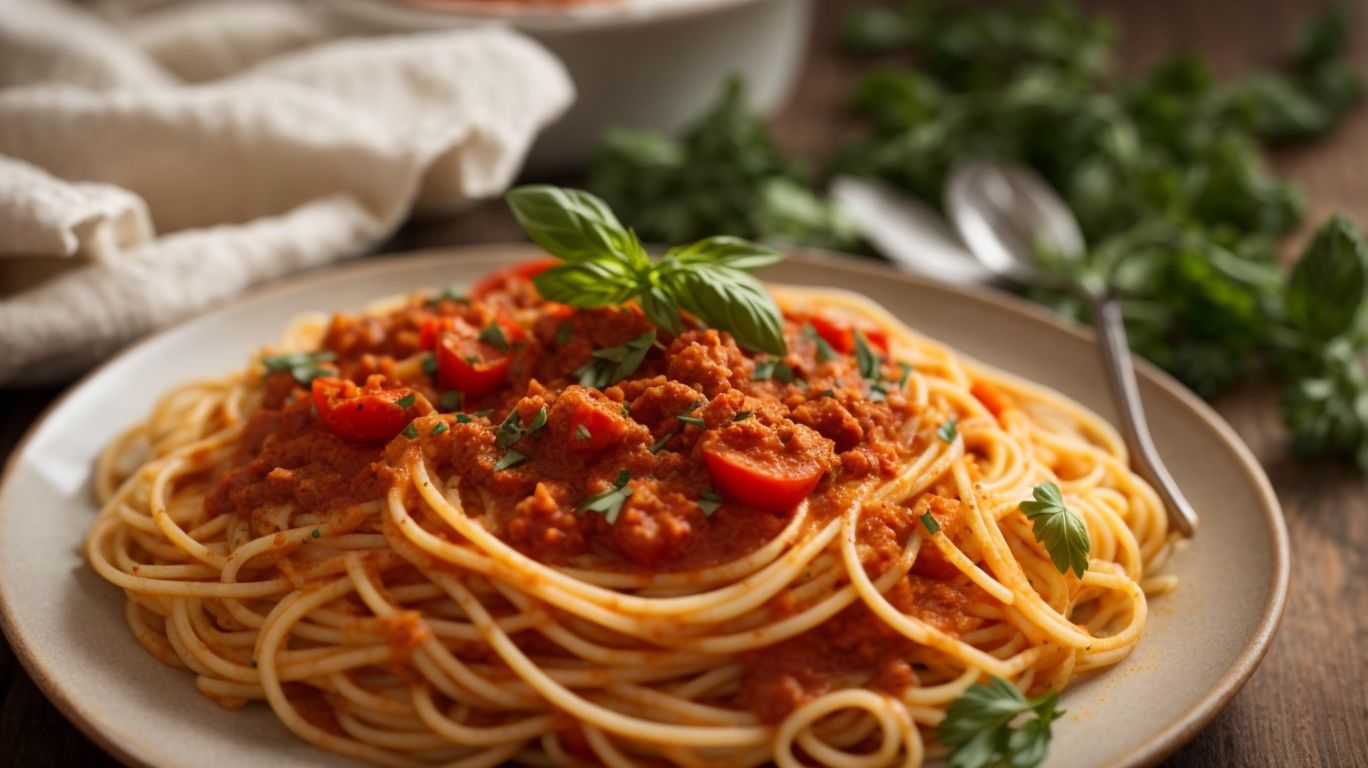
Credits: Poormet.Com – Adam Clark
Achieving the perfect spaghetti dish requires following key tips like salting the water, avoiding overcooking, saving pasta water, and adding a touch of olive oil for enhanced flavor.
Properly salting the cooking water adds essential flavor to the spaghetti itself, as the pasta absorbs the seasoning during the cooking process. This step is often underestimated but can significantly elevate the taste of the dish.
Regarding the pasta, ensuring it is cooked ‘al dente’ is crucial to achieve the ideal texture – tender yet with a slight firmness when bitten into. Keeping some pasta water before draining can be a lifesaver when adjusting the consistency of your sauce. Drizzling a bit of olive oil at the end not only adds richness but also helps prevent the strands from sticking together.
Salt the Water
Adding salt to the boiling water before cooking pasta is crucial for seasoning the noodles from within, enhancing the overall taste of the dish.
When pasta is cooked in unsalted water, it misses the opportunity to absorb flavor at its core. The process of salting the water not only seasons the pasta itself but also flavors it throughout, ensuring a more delicious final result. By salting the water, you’re essentially seasoning the pasta from the inside out, which is key for a well-balanced dish.
To achieve the ideal flavor absorption, it is recommended to add about 1-2 tablespoons of salt per gallon of water used for boiling pasta. This amount may vary based on personal preference, but it’s crucial to have a properly salted cooking liquid to bring out the best taste in your pasta.
Don’t Overcook the Pasta
To retain the perfect texture, avoid overcooking the pasta and aim for the desired al dente consistency that offers a firm bite.
Cooking pasta is truly an art form that requires precision and attention to detail. When you overcook pasta, it not only loses its delightful texture but also becomes mushy and unappetizing, affecting the overall taste and mouthfeel of your dish.
Achieving al dente perfection is key, where the pasta is cooked just enough to maintain a slight firmness in the center while being fully cooked. A helpful visual cue is to look for a thin white line in the center of a piece of pasta, indicating readiness. Timing is crucial – follow package instructions but taste-test for the ideal doneness.
Save Some Pasta Water
Reserving a small amount of pasta water before draining can help adjust the consistency of your sauce, ensuring it clings perfectly to the spaghetti.
Regarding pasta perfection, that starchy pasta water is your secret weapon, thanks to its ability to transform a watery sauce into a rich, velvety masterpiece. By adding a splash of this liquid gold to your sauce, you are infusing it with a silky texture while binding all those flavors together harmoniously.
Whether you are whipping up a classic marinara, a decadent carbonara, or a vibrant pesto, pasta water can take your sauce game to the next level. It’s a simple yet effective trick that can elevate your pasta dish from good to exceptional.
Mix in Some Olive Oil
A finishing touch of olive oil not only enhances the flavor of your spaghetti dish but also adds a silky texture to the overall presentation.
Choosing high-quality olive oil can elevate the taste profile of your spaghetti, providing a rich and fruity undertone that complements the other ingredients perfectly. The natural viscosity of olive oil contributes to a smooth and velvety mouthfeel, ensuring a satisfying dining experience.
For those looking to experiment further, infused oils such as garlic or herb-infused olive oils can introduce unique and aromatic dimensions to your dish, enhancing its complexity. The versatility of olive oil allows for endless customization, making it a staple ingredient in the culinary world.
Conclusion
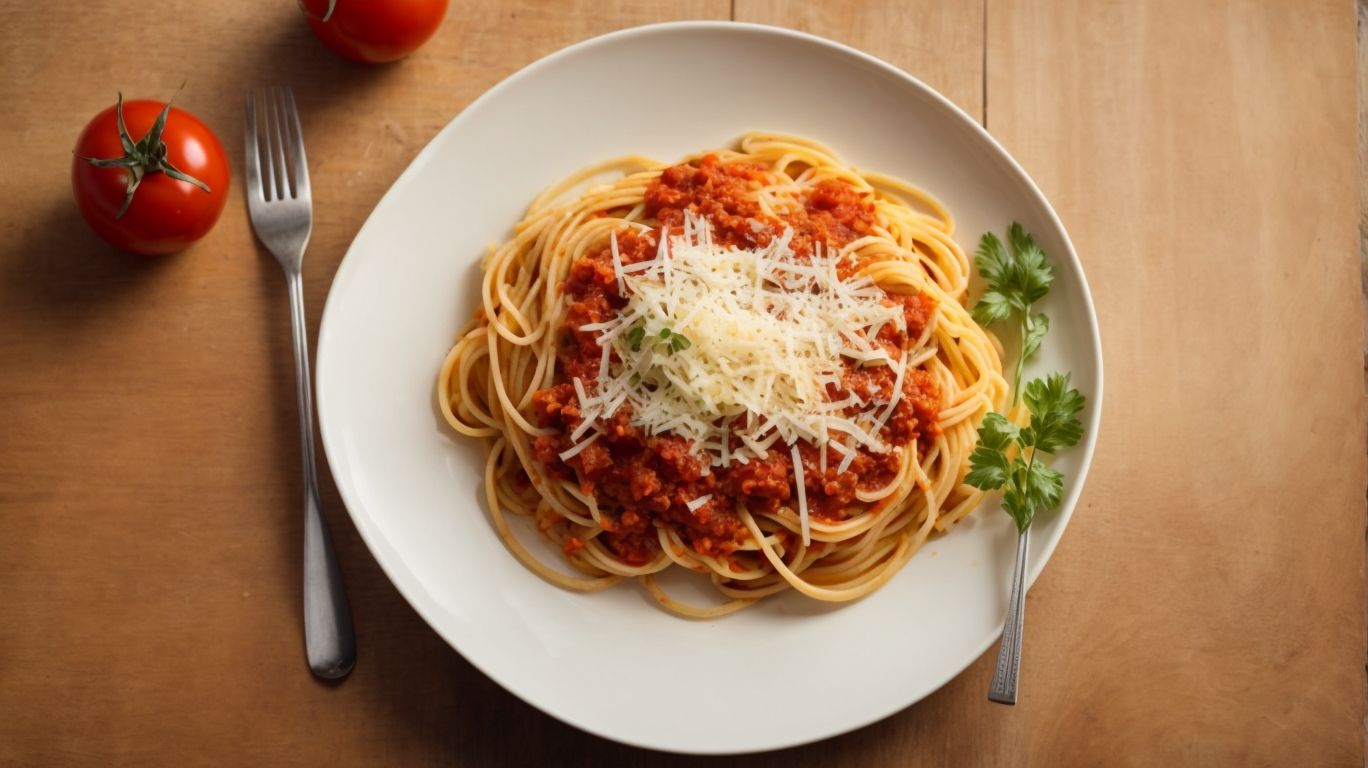
Credits: Poormet.Com – David Young
Mastering the art of cooking spaghetti opens up a world of culinary possibilities, allowing you to experiment with various ingredients, sauces, and techniques to create delightful pasta dishes.
Whether you prefer the classic marinara and meatballs or adventurous combinations like pesto with sun-dried tomatoes and pine nuts, the beauty of spaghetti lies in its adaptability to different flavors and cuisines. With the right recipe, pasta can be transformed from a simple weekday meal to an elegant dinner party centerpiece. From creamy carbonara to spicy arrabbiata, there is a pasta dish for every palate and occasion. So, don’t be afraid to get creative in the kitchen and explore the endless possibilities that spaghetti has to offer!

